Japanese Macaque
Macaca fuscata
Has cheek pouches for storing food!
Advertisement
Japanese Macaque Scientific Classification
- Kingdom
- Animalia
- Phylum
- Chordata
- Class
- Mammalia
- Order
- Primates
- Family
- Cercopithecidae
- Genus
- Macaca
- Scientific Name
- Macaca fuscata
Read our Complete Guide to Classification of Animals.
Japanese Macaque Conservation Status
Japanese Macaque Facts
- Prey
- Fruit, Young Leaves, Seeds
- Name Of Young
- Infant
- Group Behavior
- Troop
- Fun Fact
- Has cheek pouches for storing food!
- Estimated Population Size
- 50,000
- Biggest Threat
- Habitat loss
- Most Distinctive Feature
- Red and human-like, naked face
- Other Name(s)
- Snow Monkey
- Gestation Period
- 5 - 6 months
- Habitat
- Tropical forest and mountains
- Predators
- Human, Wolf, Feral Dog
- Diet
- Omnivore
- Average Litter Size
- 1
- Lifestyle
- Diurnal
- Common Name
- Japanese Macaque
- Number Of Species
- 2
- Location
- Throughout Japan
- Slogan
- Has cheek pouches for storing food!
- Group
- Mammal
Japanese Macaque Physical Characteristics
- Color
- Brown
- Grey
- Skin Type
- Fur
- Lifespan
- 25 - 32 years
- Weight
- 5kg - 14kg (11lbs - 31lbs)
- Height
- 80cm - 95cm (31.5in - 37.5in)
- Age of Sexual Maturity
- 4 - 5 years
- Age of Weaning
- 20 months
View all of the Japanese Macaque images!
The Japanese macaque is a medium-sized Monkey found in a variety of different habitats throughout Japan. The Japanese macaque is also known as the “snow monkey” as they are often found living in colder regions of the country where heavy snowfall is common during the winter. They are the world’s most northern living monkey species and have adapted incredibly to their surroundings and changing seasons. There are two different subspecies of Japanese macaque, one which is found across northern and mainland Japan, and the other is restricted to one of the country’s southern islands. The two differ very slightly in size and appearance.
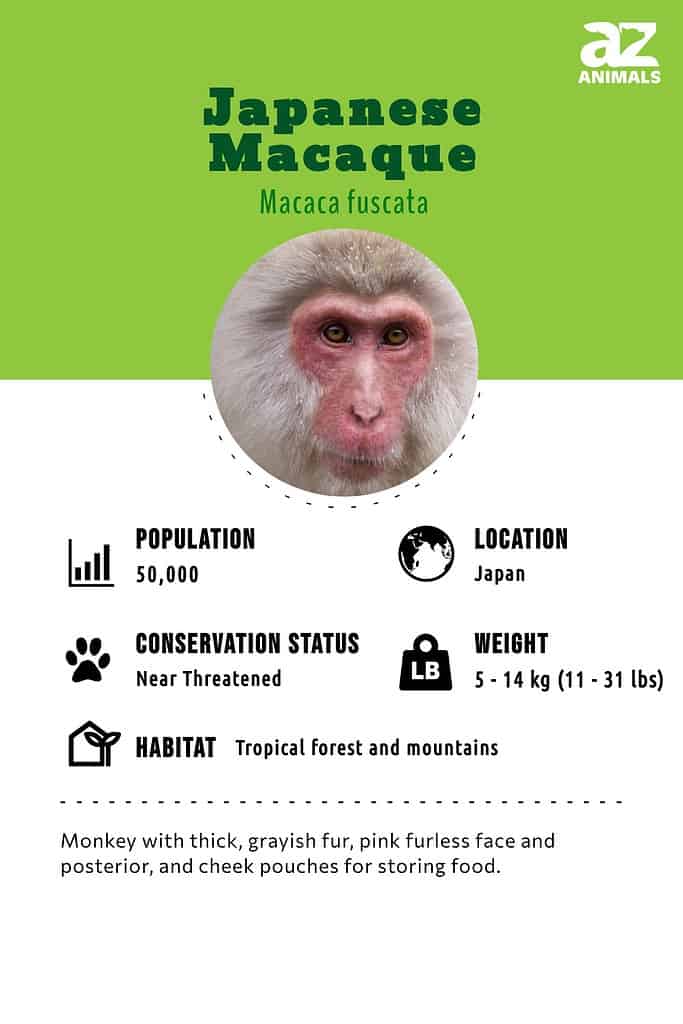
Scientific Name and Species
The Japanese macaque, (Macaca fuscata), is an Old World monkey species that is native to Japan. There are two subspecies:
- The Yakushima macaque (Macaca fuscata yakui), can be found on Yakushima Island and is also known as the Yaku macaque. These macaques are smaller and stockier than their northern counterparts and have black hands and feet. Adult males have a “momoware”, which parts their hair in the middle.
- Snow monkey (Macaca fuscata), lives in the colder regions of Japan and is renowned for bathing in hot springs. They have thick brown or grayish fur and pink hairless faces and posteriors.
Evolution
The macaque lineage originated around 9 million years ago in Africa, with modern macaques diverging around 5 – 6 million years ago. Those five species are the eastern rhesus macaque (Macaca mulatta), the long-tailed macaque (M. fascicularis), the Japanese macaque (M. fuscata), the pig-tailed macaque (M. nemestria), and the bonnet macaque (M. radiata). The Japanese macaque differentiated from the eastern rhesus macaque during the Pleistocene and the two are closely related. Japanese macaques colonized Japan after the separation of the two species, between 0.31 and 0.88 million years ago. Some scientists do not believe there is enough genetic evidence to consider the two types of Japanese macaques as two separate subspecies.

Japanese macaques are renowned for bathing in the Jigokudani Hot Spring.
©Yosemite / Creative Commons – Original
Anatomy and Appearance
The Japanese macaque has a stocky body with a naked, red face that looks astonishingly human. Their thick, furry coat is usually grey or brown in color, sometimes with a slightly mottled pattern, and grows thicker during the winter months to allow the Japanese macaque to stay warm in freezing conditions. Like other monkey species, the Japanese macaque has opposable thumbs, allowing it to grasp and hold objects and is able to walk on just its hind legs when it has something in its hands. The Japanese macaque also has large pouches in its cheeks, to allow the animal to store food whilst foraging. They have a relatively short tail for their body size (in the same way as other primarily ground-dwelling Monkeys), and males tend to be somewhat larger than their female counterparts.
Distribution and Habitat
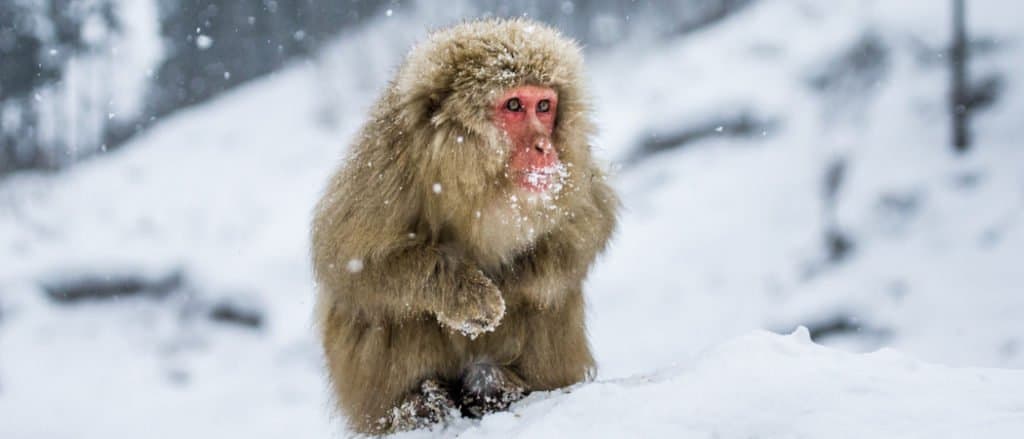
Japanese macaques living in the northern and central parts of Japan have to contend with snowy, cold conditions.
©GUDKOV ANDREY/Shutterstock.com
The Japanese Macaque is found in four separate regions in Japan throughout a variety of habitats from subtropical jungles to hot mountain springs, in forested hills, across highlands, and high up in the mountains. In the northern and central parts of Japan, Japanese macaques have to withstand seasonal changes with temperatures ranging from -15 degrees Centigrade in the winter to more than 23 in the summer, where the vegetation primarily consists of deciduous trees and conifers. In their most southern range, on the island of Yaku-Shima, the Japanese macaques live amongst tropical broad-leaf forests that are subjected to less seasonal change. In central Japan, the Japanese macaques are found in the mountains, where they warm themselves in the hot springs that are heated by nearby volcanoes.
Behavior and Lifestyle
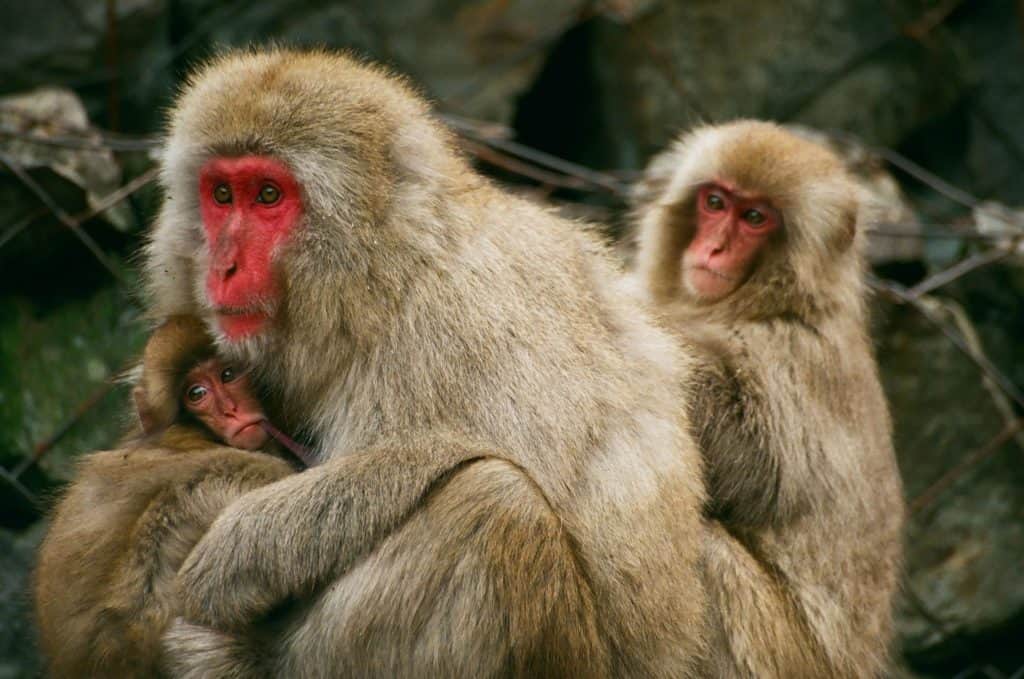
Japanese macaques live in troops of 20 – 30 individuals led by an alpha male.
©bryan… / Flickr – Original
Japanese macaques live together in troops that are led by the alpha male and usually consist of between 20 and 30 individuals. The alpha male not only helps to sire young, but also decides where the troop should go, and protects it from both predators and other Japanese macaque troops. Social rank is very important in Japanese macaque society and consists of both males and females, with the male’s rank often determined by his age. Offspring are thought to inherit the rank of their mother. Japanese macaques are incredibly sociable animals, particularly the females who tend to remain in the same troop for their whole lives and spend their time together, grooming and raising the troop’s young.
Reproduction and Life Cycles
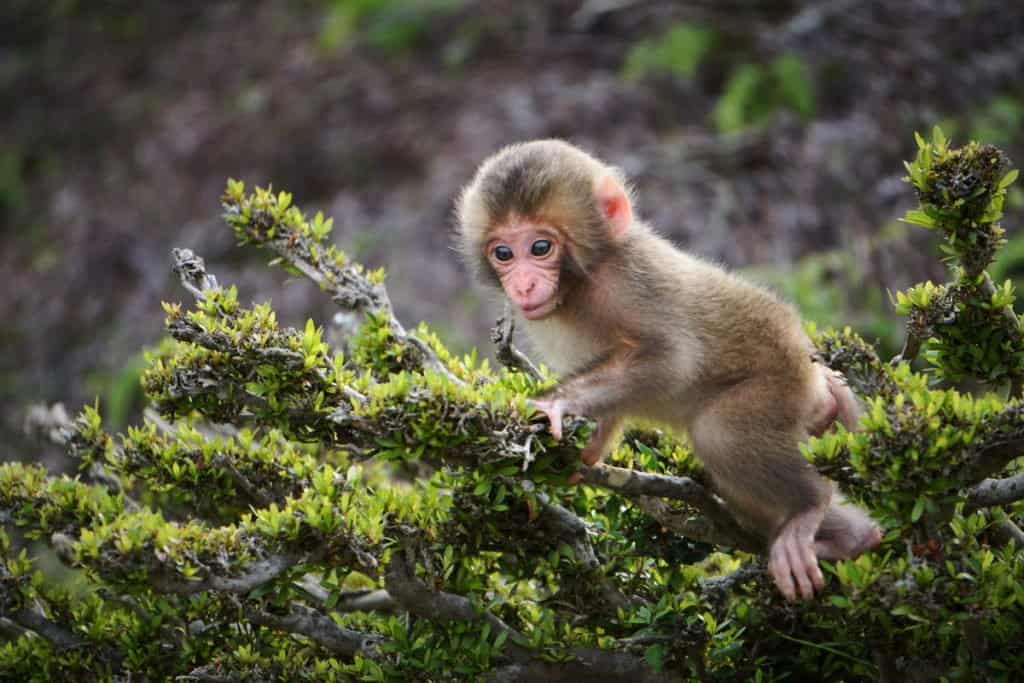
Baby Japanese macaques are dependent on their mothers for the first couple of years.
©achikochi/Shutterstock.com
Female Japanese macaques tend to reach sexual maturity about a year earlier than males, between the ages of four and five. She usually chooses her mate by his rank, and after a gestation period that lasts for up to 6 months, the female gives birth to a single infant. Baby Japanese macaques are incredibly dependent on their mother and remain clinging to her for their first couple of years, meaning that mother and baby often have a very close bond. Once weaned, males often leave the troop and spend their lives traveling between others, while females generally remain in the same troop that they were born into. Japanese macaques tend to live for a relatively long time, often reaching age 30 or more.
Diet and Prey

The Japanese macaque is an omnivorous animal meaning that it forages for both plants and smaller animals in order to survive. Unlike a number of other monkey species, Japanese macaques are primarily ground-dwelling so the majority of their foraging is done on the ground. They mainly eat fruits, berries, seeds, young leaves, and flowers which they pick from the surrounding vegetation before storing them in their cheek pouches, so that they can continue to gather more. They also supplement their diet with Crabs, Insects, and birds’ eggs particularly during the colder winter months when there are slim pickings on the branches. Japanese macaque babies feed on their mother’s milk until they are able to begin eating more solid foods.
Predators and Threats
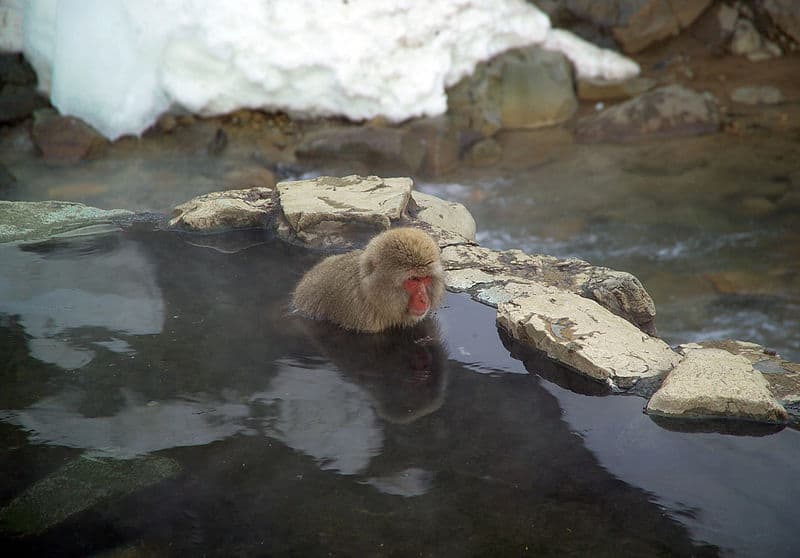
Japanese macaques are mostly threatened by human encroachment on their native ranges.
©Fg2 – Public Domain
Due to their fairly large size and diverse habitat ranges, the Japanese macaque has no real predators in their natural environment, perhaps with the exception of the occasional hungry Wolf or feral Dog. Humans are the primary threat to the Japanese macaque as they are often killed by farmers when they approach livestock and crops. However, the only reason that these conflicts occur is that the Japanese macaque is being pushed into smaller and smaller pockets of its native ranges, due to deforestation and growing human settlements. During the colder winter months, Japanese macaque individuals in the north are also known to sleep in the deciduous trees to protect them from being buried in large amounts of snow during the night.
Interesting Facts and Features
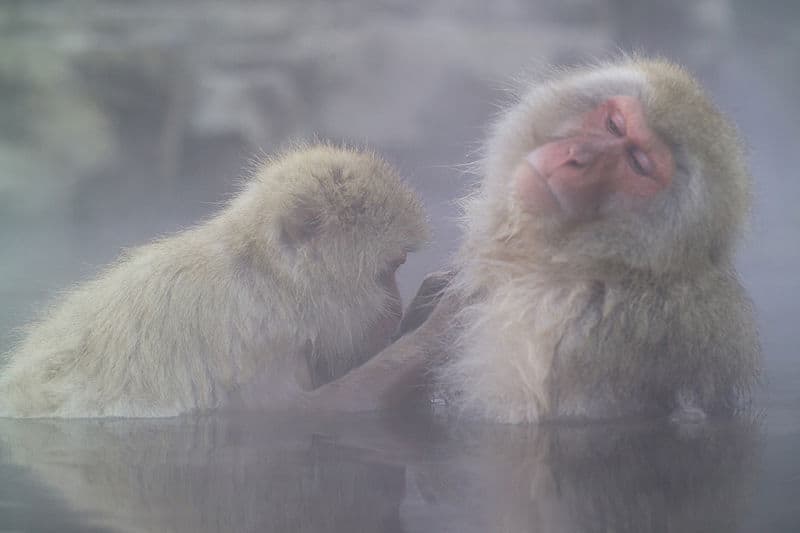
Female Japanese macaques have strict rules about mating to prevent inbreeding and are responsible for discovering the benefits of the hot spring.
©Fg2 – Public Domain
The females are actually very picky when choosing a mate, as they will not mate with a male Japanese macaque that they have mated within the past few years, to prevent interbreeding within the troop. Japanese macaques, particularly in the north, have different home ranges for the changing seasons which leads to their wide variety in diet and different habitats. They are incredibly intelligent and adaptable animals and are known to pass new behaviors through the generations. In the mid-1900s a female was seen entering a hot spring to gather dropped soybeans and today, whole troops can be seen resting in the steaming waters to keep themselves warm.
Relationship with Humans
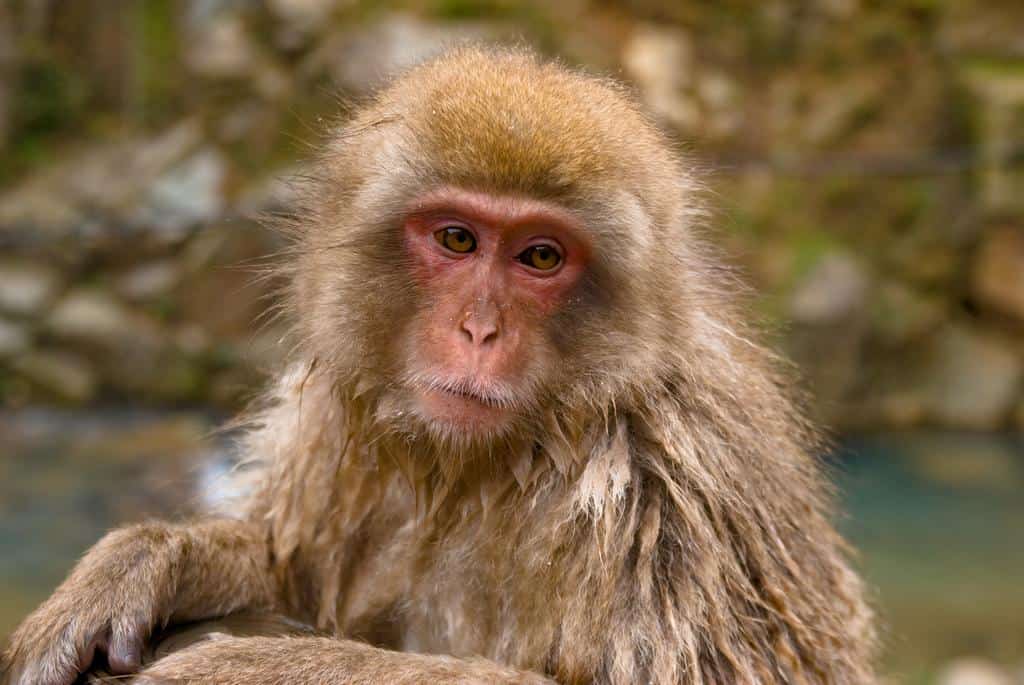
Japanese macaques are often killed by farmers after they raid crops.
©Christopher Liang / Flickr – Original
Like many of the 22 monkey species found across Japan, the Japanese macaque is often loved and protected by the native people. However, growing human settlements and land clearance for logging and agriculture has meant that Japanese macaques have lost vast areas of their natural habitats, and often have to approach farmland in order to find better food supplies. It is estimated that, despite being a protected species in Japan today, around 5,000 Japanese macaque individuals are killed every year by farmers who claim to be protecting their livestock and their crops. In the Nagano Mountains in central Japan though, the Japanese macaques that bathe in the hot springs have become one of the country’s most desirable tourist attractions.
Conservation Status and Life Today
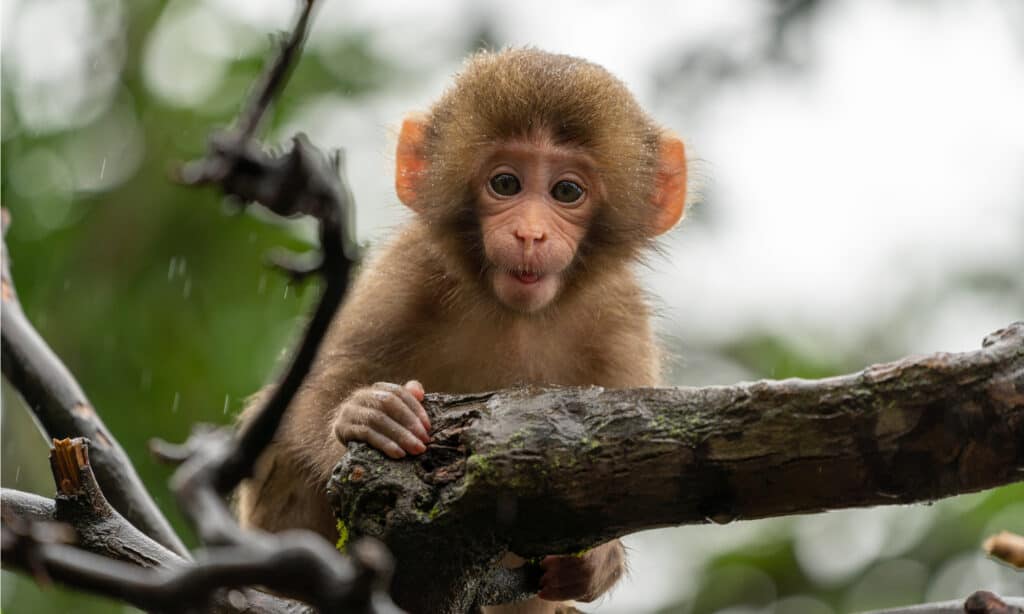
The Japanese macaque is listed as threatened by the IUCN.
©exs_yori/Shutterstock.com
Today, the Japanese macaque has been listed as a Threatened species by the IUCN, with the southern subspecies of the Japanese macaque listed as Endangered. It is estimated that there could be as few as 50,000 individuals remaining in Japan today, but numbers are still declining particularly seeing that they are often killed, as they are seen as pests by local people.
View all 36 animals that start with JJapanese Macaque FAQs (Frequently Asked Questions)
Are Japanese Macaques herbivores, carnivores, or omnivores?
Japanese Macaques are Omnivores, meaning they eat both plants and other animals.
What Kingdom do Japanese Macaques belong to?
Japanese Macaques belong to the Kingdom Animalia.
What phylum to Japanese Macaques belong to?
Japanese Macaques belong to the phylum Chordata.
What family do Japanese Macaques belong to?
Japanese Macaques belong to the family Cercopithecidae.
What order do Japanese Macaques belong to?
Japanese Macaques belong to the order Primates.
What type of covering do Japanese Macaques have?
Japanese Macaques are covered in Fur.
What genus do Japanese Macaques belong to?
Japanese Macaques belong to the genus Macaca.
Where do Japanese Macaques live?
Japanese Macaques live throughout Japan.
In what type of habitat do Japanese Macaques live?
Japanese Macaques live in tropical forests and mountains.
What are some predators of Japanese Macaques?
Predators of Japanese Macaques include humans, wolves, and feral dogs.
How many babies do Japanese Macaques have?
The average number of babies a Japanese Macaque has is 1.
What is an interesting fact about Japanese Macaques?
Japanese Macaques have cheek pouches for storing food!
What is the scientific name for the Japanese Macaque?
The scientific name for the Japanese Macaque is Macaca fuscata.
What is the lifespan of a Japanese Macaque?
Japanese Macaques can live for 25 to 32 years.
How many species of Japanese Macaque are there?
There are 2 species of Japanese Macaque.
What is the biggest threat to the Japanese Macaque?
The biggest threat to the Japanese Macaque is habitat loss.
What is another name for the Japanese Macaque?
The Japanese Macaque is also called the snow monkey.
How many Japanese Macaques are left in the world?
There are 50,000 Japanese Macaques left in the world.
How to say Japanese Macaque in ...
Thank you for reading! Have some feedback for us? Contact the AZ Animals editorial team.
Sources
- David Burnie, Dorling Kindersley (2011) Animal, The Definitive Visual Guide To The World's Wildlife / Accessed April 6, 2011
- Tom Jackson, Lorenz Books (2007) The World Encyclopedia Of Animals / Accessed April 6, 2011
- David Burnie, Kingfisher (2011) The Kingfisher Animal Encyclopedia / Accessed April 6, 2011
- Richard Mackay, University of California Press (2009) The Atlas Of Endangered Species / Accessed April 6, 2011
- David Burnie, Dorling Kindersley (2008) Illustrated Encyclopedia Of Animals / Accessed April 6, 2011
- Dorling Kindersley (2006) Dorling Kindersley Encyclopedia Of Animals / Accessed April 6, 2011
- David W. Macdonald, Oxford University Press (2010) The Encyclopedia Of Mammals / Accessed April 6, 2011
- Japanese Macaque Information / Accessed April 6, 2011
- Japanese Macaque Habitat / Accessed April 6, 2011
- About Japanese Macaques / Accessed April 6, 2011
- Japanese Macaque Diet / Accessed April 6, 2011
- Japanese Macaque Species / Accessed April 6, 2011


















